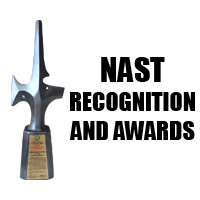Two distinguished finalists vying for the 2015 NAST Environmental Science Award (NESA) brought home the coveted prize during the paper presentation of finalists and awarding ceremony of NESA on April 22, 2015 held at New World Manila Bay Hotel. The award was given by the National Academy of Science and Technology, Philippines (NAST PHL), the country’s foremost recognition body, in partnership with the Department of Science and Technology (DOST) and the Department of Environment and Natural Resources (DENR).
Mr. Arsenio B. Ella, Scientist III of the Forest Products Research and Development Institute (FPRDI), DOST and Dr. Severino G. Salmo, III, assistant professor and chairperson of the Department of Environmental Science, Ateneo de Manila University (ADMU) tied for first prize for said award, the second time since the inception of the award in 2001.
Mr. Arsenio B. Ella, Scientist III of the Forest Products Research and Development Institute (FPRDI), DOST and Dr. Severino G. Salmo, III, assistant professor and chairperson of the Department of Environmental Science, Ateneo de Manila University (ADMU) tied for first prize for said award, the second time since the inception of the award in 2001.
Ella was recognized for his exemplary contributions in the field of forest products utilization research. Spanning 41 years of hard and dedicated work as a researcher at FPRDI, Ella is credited for a number of notable R&D contributions, including the generation of technical information and technologies on exudates-producing plants that led to the formulation of standards and guidelines towards improved methods of harvesting resins, such as the Manila copal (Almaciga resin), Manila elemi (Canarium resin), balau (Apitong resin), oleoresin (Benguet pine resin), and oil of palosapis (Anisoptera resin). These initiatives have contributed to the conservation of species that produce resins and to prolonging the life span of trees, sustaining and maximizing resin production, generating scientific knowledge and technical skills in non-wood forest products utilization. These in turn have contributed to poverty reduction, and livelihood enhancement among the more marginalized sectors of our society, especially the indigenous communities.
Salmo was recognized for his important studies on the impacts of mangrove restoration program in terms of the recovery of forest cover and its contribution in the enhancement of macrofaunal communities. His researches have contributed to the scientific advancement of the mangrove restoration programs in the country primarily in the promotion of mangrove conservation program. His other major contributions include: the identification of restoration indicators, tracking of restoration trajectories, and more importantly, in formulating an estimation that it will take 15-25 years for the restored mangroves to match the ecosystem structure and habitat functionality of natural mangroves. He also recommended use of more mangrove species for the restoration of mangrove forests.
Salmo was recognized for his important studies on the impacts of mangrove restoration program in terms of the recovery of forest cover and its contribution in the enhancement of macrofaunal communities. His researches have contributed to the scientific advancement of the mangrove restoration programs in the country primarily in the promotion of mangrove conservation program. His other major contributions include: the identification of restoration indicators, tracking of restoration trajectories, and more importantly, in formulating an estimation that it will take 15-25 years for the restored mangroves to match the ecosystem structure and habitat functionality of natural mangroves. He also recommended use of more mangrove species for the restoration of mangrove forests.
NESA is given to outstanding scientific and technological researches that contribute to environmental protection and conservation.. First launched in 2001 as the Academy’s contribution in the celebration of the World Earth Day, through the efforts of the late National Scientist Perla D. Santos Ocampo, this award was formerly called NAST-Hugh Greenwood Environmental Science Award
On the other hand, five finalists competed for the 2015 NAST Talent Search for Young Scientists award presented their papers in the afternoon of April 22 at the stated venue. The finalists and their papers are: (1) Dr. Romar B. dela Cruz, assistant professor, Institute of Mathematics, UP Diliman, “Cheating-immune secret schemes from codes and cumulative arrays”; (2) Dr. Charlotte Kendra D.Z. Gotangco, assistant professor, Department of Environmental Science, ADMU, “A sensitivity analysis of surface biophysical, carbon, and climate impacts of tropical deforestation rates in CCSM4-CNDV”; (3) Ms. Rose Ann G. Franco, assistant professor, Institute of Biological Sciences, UP Los Baños, “Utilization of polyvinylphosphonic acid (PVPA) and its effect on the material properties and biocompatibility of polyvinyl alcohol (PVA) electrospun membranes”; (4) Dr. Drandreb Earl O. Juanico, research director, Technological Institute of the Philippines (TIP), “Epidemic cycle induced by intervention in a susceptibility-structured population”; and Dr. Pierangeli G. Vital, assistant professor, Institute of Biology, UP Diliman, “Microbiology quality of fresh produce from open air markets and supermarkets in the Philippines.”
Winners for the NTSYS award will be announced on the first week of June. The awarding ceremony will be held during the NAST Annual Scientific Meeting in July, together with other NAST awards.
The NTSYS award recognizes young scientists and technologists to encourage them to further pursue their careers in science. The five finalists were selected from a total of seventeen competitors. Trophies and cash prizes will be presented to the winners during the NAST Annual Scientific Meeting awarding ceremonies on July 9, 2015.
The two events were attended by 127 participants from the science community, different academic institutions, private and government agencies, and friends from the media. (Darvin S. Rosa)











